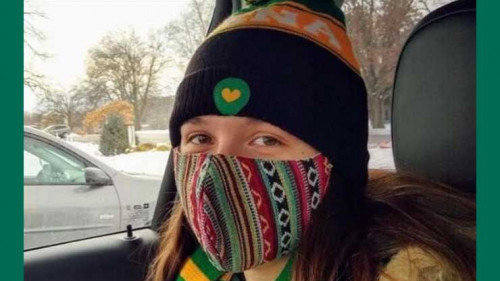
Each week, the three religious studies students gather in their professor’s book-lined office to painstakingly learn the rudiments of the Hebrew language.
You might assume they chose the class because they have a Jewish faith tradition. The “faith tradition” part is correct, but not one of them is Jewish – although their professor is.
All three are learning the ancient language to better inform the understanding of their own faiths – Alyssa Lewis ’20, a devout Roman Catholic; Ridhwan Sebkhaoui ‘20, a Muslim, and Bavnouti Mansour ‘20, a Coptic Orthodox Christian. Under the instruction of Peter Zaas, Ph.D., professor of religious studies, in their twice-weekly tutorial they learn to read and write the ancient characters using texts, online sources, and a chisel pen to paper.
“This is the first time I’ve ever had a group as diverse as this study Hebrew,” said Zaas. “It is such a pleasure to teach this. This little class – all of them future educators - may change the world in ways we can’t imagine as they go on to teach others in the future. I’m impressed that they’re taking the time to study something outside their own faith traditions.”
Mansour, whose father is a priest at St. Mary St. George Coptic Orthodox Church in Albany, is a biology major (religious studies minor) who will be going to dental school this fall.
“I took this to help me better understand the Old Testament,” said Mansour. “It offers a new angle on the Scriptures, and why certain translations were made the way they were. I find it interesting how a word in Hebrew can mean two different things in English, and that impacts a translation.”
Sebkhaoui and Mansour are both native Arabic speakers, and since Arabic and Hebrew have roots in the same Semitic language family and read right to left, they had a bit of a head start. Sebkhaoui calls Hebrew a “close uncle” of Arabic, but noted that there is not enough similarity to make it a walk in the park.
“It helps me to think of the figures as symbols rather than letters,” he said. “I definitely assumed it would be closer to Arabic than it actually is, but the two languages do share some vocabulary.”
Sebkhaoui is active at the Masjid Al-Hidaya Islamic mosque and community center in Latham, teaching his young students how to read and memorize the Quran.
“My passion is to study Islam broadly, possibly in Turkey in the near future.”
Lewis, religious studies major with an education certificate who requested the Hebrew tutorial be offered, plans on a career in Catholic education. She’s already interned as a religious education teacher at St. Vincent’s Church in Albany.
“I studied Spanish before, so I have experience with learning a new language,” she said. “The process is similar – you have to take baby steps, learning new words and pronunciation, and let yourself be vulnerable in the learning process.”
An interesting note: Lewis is dyslexic, and she was curious as to how her cognitive difference would manifest itself in the study of a language that reads text in a different direction. So far, she’s finding it a little easier than reading English.
The students joked that Zaas is “very patient” with them, and he in turn is enjoying the tutorial experience.
“They’re all very motivated,” he said. “We’ll go as slowly as we need to go, but they are all really making excellent progress. It’s a pleasure to work with students who are this motivated.”
Zaas said the Religious Studies department at Siena offers a variety of ancient languages. He has tutored students in biblical, rabbinic and modern Hebrew, as well as biblical Greek. Other department faculty have offered tutorials in Latin, Arabic and Aramaic.